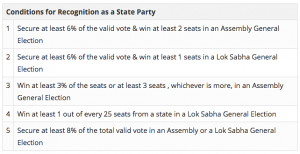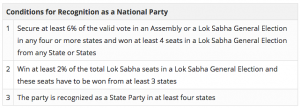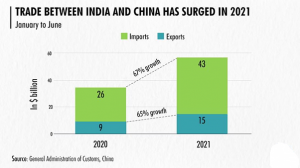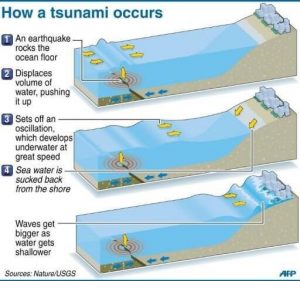Table of Contents
THE POLITY AND GOVERNANCE
1. THE REGISTRATION OF POLITICAL PARTIES
THE CONTEXT: The Election Commission of India reduced the notice period from 30 days to seven
days for registration of political parties under Section 29A of the Representation of the People Act,
1951, in view of the ongoing third wave of the Covid-19 pandemic.
THE EXPLANATION:
- The Election Commission had announced the poll schedule for Assembly elections in five
states — Uttar Pradesh, Punjab, Goa, Uttarakhand and Manipur. - A party seeking registration under the section 29A of the Representation of the People’s
Act with the Commission has to submit an application to the Commission within a period of
30 days following the date of its formation as per guidelines prescribed by the Commission
in exercise of the powers conferred by Article 324 of the Constitution of India.
Why registering with the EC is important?
- It is not mandatory to register with the Election Commission but registering as a political
party with the EC has its advantage in terms of intending to avail itself of the provisions of
the Representation of the People Act, 1951, (relating to registration of political parties). - The candidates set up by a political party registered with the EC will get preference in the
matter of allotment of free symbols vis-à-vis purely independent candidates. - More importantly, these registered political parties, over course of time, can get recognition
as a ‘state party’ or a ‘national party’ subject to the fulfilment of the conditions prescribed
by the Commission in the Election Symbols (Reservation and Allotment) Order, 1968. - As per the rules, if a party is recognised as a ‘state party’, it is entitled for exclusive
allotment of its reserved symbol to the candidates set up by it in the state in which it is so
recognised, and if a party is recognised as a ‘national party’ it is entitled for exclusive
allotment of its reserved symbol to the candidates set up by it throughout India. - Recognised ‘state’ and ‘national’ parties need only one proposer for filing the nomination
and are also entitled for two sets of electoral rolls free of cost and broadcast/telecast
facilities over state-owned Akashvani/Doordarshan during the general elections.


THE ECONOMIC DEVELOPMENT
2. INDIA-CHINA TRADE GROWS TO RECORD $125 BILLION IN 2021
THE CONTEXT: According to the official data, two-way trade between India and China in 2021 stood
at $125.66 billion, up 43.3% from 2020 when bilateral trade was worth $87.6 billion.
THE EXPLANATION:
- Regardless of the disputes and military standoffs, bilateral trade between India and China
reached a new high of over $125 billion in 2021, surpassing the $100 billion mark in a year,
while India's trade deficit grew to over $69 billion. - For more than a decade, India has expressed its alarm over China's rising trade deficit,
urging Beijing to open its markets to Indian IT and pharmaceutical companies. - The border stand off between India and China armies began on May 5 last year after a
violent confrontation in the Pangong lake areas, and both sides have gradually increased
their deployment by pouring in tens of thousands of soldiers and heavy weaponry. Each side currently has around 50,000 to 60,000 troops along the Line of Actual Control (LAC) in the mountainous sector.

THE ENVIRONMENT AND ECOLOGY
3. AQUACULTURE TURNED KOLLERU LAKE
THE CONTEXT: Local farmers residing nearby area’s of kolleru lake, practicing Aquaculture in large scale
leads to local carp and shrimp industry expanded, the fish ponds to harvest them have been built farther
into the lake, and the water has been severely degraded.
THE EXPLANATION:
- Commercial fishing came to Andhra Pradesh in 1975, when the state allowed Kolleru Lake’s
shoreline and shallows to be converted to fish farms. In the ensuing decades, the
international demand for fish and shrimp products rapidly expanded, and farmers
increasingly transitioned from rice to aquaculture with the help of government subsidies. - In the process, the aquaculture industry encroached farther and farther into the lake.
Around the same time, in 1999, the region was named a sanctuary under India’s Wildlife
Protection Act. And in 2002, the Kolleru wetland was named a Ramsar site, a designation
given to wetlands considered to be of international importance. - The rapid development is a double-edged sword in Andhra Pradesh, India’s top seafood
exporter. Local communities overwhelmingly support aquaculture’s expansion, but they
also lament the loss of the lake as a source of food and drinking water. - Scientists point not just to the pollution, but also to the dramatic declines in native fishes
and migratory birds. The ecological imbalance will only get worse, they say, if the region’s
aquaculture is allowed to expand.
About Kolleru Lake and Aquaculture :
- Kolleru is a largest freshwater lake and is located in Andhra Pradesh.
- It has been a bed for several migratory birds and has been acting as the flood balancing
reservoir between two river deltas, Krishna and Godavari. Aquaculture, also known as
aquafarming, is a practice of rearing aquatic creatures for commercial food purposes. - Aquaculture is the fastest growing food production industry in the world, according to the
UN’s Food and Agriculture Organisation, and India ranks second globally in aquaculture fish
production, contributing more than 8 percent of the world’s farm-raised fish.
THE DEFENCE AND SECURITY
4. THE BRAHMOS ORDER FROM PHILIPPINES
THE CONTEXT: The BrahMos, the supersonic cruise missile system jointly made by India and Russia,
has been selected by the Philippines under a $374.96 million deal, making it the first export order
for the missile.
THE EXPLANATION:
- In recent years the Philippines has repeatedly accused China of violating its EEZ by sending
hundreds of militia boats into its waters. - The new anti-ship system aims to deter foreign vessels from encroaching on the country’s
200-nautical-mile (370km) exclusive economic zone (EEZ). Indonesia, Vietnam and Thailand
are other South-East Asian countries that have shown interest in the system. - India has already deployed a sizeable number of the BrahMos missiles in several strategic
locations along the Line of Actual Control in Ladakh and Arunachal Pradesh.

About the Missile:
- BrahMos Missile is a medium-range ramjet supersonic cruise missile. It can be launched
from land, aircraft, submarine or ships. It is one of the fastest supersonic cruise missiles
worldwide. The missile is a joint venture between the Russia’s NPO Mashinostroyeniya and
India’s Defence Research and Development Organisation (DRDO). - Both the organisation has together formed BrahMos Aerospace. It is based on Russian P-
800 Oniks cruise missile. The name BrahMos has been taken from the names of two rivers,
River Brahmaputra of India and River Moskva of Russia.
Characteristics of BrahMos
- BrahMos is the fastest anti-ship cruise missile of the world, currently in operation. Its land-
launched and ship-launched versions are already there in service. In 2012, air-launched
variant of BrahMos appeared and entered the service in 2019. - Presently, a hypersonic version of the Missile called BrahMos-II, is under development. It has the speed of Mach 7–8. Missile is likely to be ready for testing by 2024.
Missile Technology Control Regime (MTCR)
India became a member of MTCR in 2016. With this partnership, India and Russia are planning to
develop a new generation of Brahmos missiles with a range of 800 km-plus. It has the ability to hit
protected targets with pinpoint accuracy.
THE DISASTER MANAGEMENT
5. THE VOLCANIC ERUPTION AND TSUNAMI HIT TONGA AND THE PACIFIC
THE CONTEXT: An underwater volcano near Tonga has erupted for the third time in January 2021
potentially threatening the ability of surveillance flights to assess the damage to the Pacific island
nation.
THE EXPLANATION:
According to Australia's meteorological service eruption was likely the biggest recorded anywhere
on the planet in more than 30 years, according to experts. Dramatic images from space captured
the eruption in real time, as a huge plume of ash, gas and steam was spewed up to 20 kilometers
(12.4 miles) into the atmosphere — and tsunami waves were sent crashing across the Pacific.
Where is Tonga's Hunga-Tonga-Hunga-Ha'apai volcano?
- Tonga is a Polynesian country of more than 170 South Pacific islands and home to about
100,000 people. It's a remote archipelago that lies about 800 kilometers (500 miles) east of
Fiji and 2,380 kilometers (1,500 miles) from New Zealand. - The Hunga-Tonga-Hunga-Ha'apai volcano, about 30 kilometers (20 miles) southeast of
Tonga's Fonuafo'ou island, sits underwater between two small islands at about 2,000
meters (6,500 feet) high from the sea floor, with about 100 meters (328 feet) visible above
sea level.

Where did the tsunami hit?
- The eruption caused a tsunami on Tonga's largest island, Tongatapu, with waves recorded
at 1.2 meters (about 4 feet) near Nuku’alofa city flowing onto coastal roads and flooding
properties. - Tsunami warnings went into effect across Pacific Island nations including Fiji, Samoa and
Vanuatu. Footage from the ground in Fiji shows people fleeing to higher ground in the
capital, Suva, as large waves hit the coast.

THE PRELIMS PRACTICE QUESTIONS
QUESTION OF THE DAY 17 TH JANUARY 2022
Q1. Vitamin-D plays vital role in which of the following?
1. Metabolic functions
2. Bone health
3. Immune system
4. Mental health
Select the correct answer using code given below:
a) 1 and 2 only
b) 2 and 3 only
c) 2, 3 and 4 only
d) All of them
ANSWER FOR 14 TH JANUARY 2022.
Answer: b)
Explanation:
1. Nuakhai – Odisha
2. Wangala – Garo, Meghalaya
3. Bihu – Assam
4. Onam – Kerala

